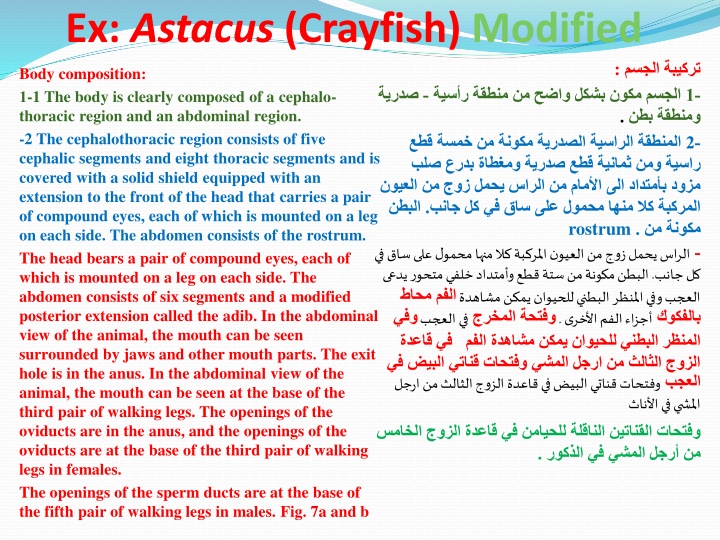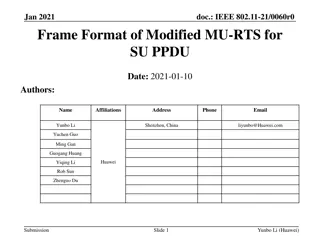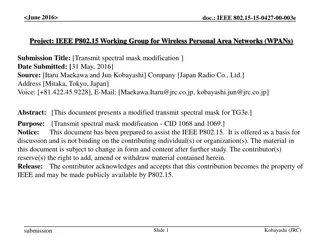
Astacus Crayfish Anatomy and Systems Overview
Explore the detailed anatomy of Astacus crayfish, including body composition, digestive system, internal anatomy, and nervous system. Learn about the cephalothoracic and abdominal regions, the digestive tract's three regions, and the unique nervous system characteristics of crustaceans. Discover the incredible complexity of these fascinating creatures.
Uploaded on | 0 Views
Download Presentation

Please find below an Image/Link to download the presentation.
The content on the website is provided AS IS for your information and personal use only. It may not be sold, licensed, or shared on other websites without obtaining consent from the author. If you encounter any issues during the download, it is possible that the publisher has removed the file from their server.
You are allowed to download the files provided on this website for personal or commercial use, subject to the condition that they are used lawfully. All files are the property of their respective owners.
The content on the website is provided AS IS for your information and personal use only. It may not be sold, licensed, or shared on other websites without obtaining consent from the author.
E N D
Presentation Transcript
Ex: Astacus (Crayfish) Modified : Body composition: 1-1 The body is clearly composed of a cephalo- thoracic region and an abdominal region. -2 The cephalothoracic region consists of five cephalic segments and eight thoracic segments and is covered with a solid shield equipped with an extension to the front of the head that carries a pair of compound eyes, each of which is mounted on a leg on each side. The abdomen consists of the rostrum. The head bears a pair of compound eyes, each of which is mounted on a leg on each side. The abdomen consists of six segments and a modified posterior extension called the adib. In the abdominal view of the animal, the mouth can be seen surrounded by jaws and other mouth parts. The exit hole is in the anus. In the abdominal view of the animal, the mouth can be seen at the base of the third pair of walking legs. The openings of the oviducts are in the anus, and the openings of the oviducts are at the base of the third pair of walking legs in females. The openings of the sperm ducts are at the base of the fifth pair of walking legs in males. Fig. 7a and b - - 1 . . - 2 rostrum . - . . .
Ex: Astacus (Crayfish) , Astacus Figure 7-B: General appearance of the genus Ventral appearance Figure 7-A: The general appearance of the genus Astacus is a dorsal appearance
Digestive System Modified Digestive system The gastrointestinal tract is divided into three regions: 1- Front channel : Foregut: It begins with the mouth, which opens in the ventral surface and leads to a short esophagus and then to the stomach. The stomach is divided into two main parts: the cardial stomach and the pyloric stomach. The heart stomach consists of a large sac in which food is stored while digestion takes place in the pyloric stomach. The digestive glands are usually called livers, and their secretions are proteolytic and fat-breaking. They are located on each side of the pyloric stomach, two of which are lateral in location and one is dorsal, which produce digestive enzymes. 2- The middle channel: Midgut This part of the alimentary canal consists of a short intestine, where absorption takes place. 3- Back channel: Hindgut It is made up of the long straight intestine, which expands just before the outlet opening to form the short rectum Undigested material passes into the posterior canal, which opens to the outlet, Figure 8. : : Foregut Midgut - Hindgut - 1 2 - 3 - : 1 . . .. . : 2 . : 3 . 8 .
, Astacus Figure 8: Sex A- Internal anatomy of the female, B- Longitudinal section of the stomach)
Nervous system :in Astacus : Nervous system : The nervous systems of crustaceans and annelid worms share many characteristics, but the nervous systems of crustaceans have a fusion that prepares the supraesophageal ganglia, represented by a pair of nerve ganglia above the esophageal brain, larger than the nerve ganglia. The brain has nerves for the eyes and the first and second pairs of tentacles, and there are at least five pairs of nerve ganglia united together that supply Cord . antennal glands, esophagus, esophagus, appendages, and mouth appendages Nerves to the mouth The double ventral nerve has a pair of nerve ganglia in each ring of the body, with nerves extending to the appendages, muscles, and other parts (Figure 8 and Figure 9). supraesophageal ganglia ) 8 9 . ) Figure 9: The nervous system of the genus Astacus
Circulatory system Modified Circulatory system : The heart is a bag of striated muscles and is located in the dorsal part of the chest area. The animal has an open- type circulatory system (without fine blood vessels), with the ventral aorta towards the back and the dorsal aorta towards the front. Blood flows over the gills before returning to the heart. Blood enters the heart through three pairs of openings. Blood flows from the dorsal arteries into the capillary blood vessels and then into tissue spaces called vascular spaces or sinuses that act as veins. : : . ( . ) . . Figure 10: The circulatory systemAstacus
Excretory system Modified Excretory system The excretory system is located in the anterior vertical region of the esophagus and consists of a pair of excretory glands called tentacle glands or green glands that open outward through a defecatory opening located on the ventral surface of the tentacle ring. Each of the green glands consists of a terminal sac and a labyrinth gland. It is distinguished by its green color and is a network of waste removal ducts, an excretory duct, and a bladder, Figure 11 11 Figure 11: The excretory system in the genus Astacus
Respiratory system 17 Respiratory system The respiratory system contains 17 pairs of gills located in the two respiratory halls located on the sides between the shield and the body. The gills are attached to the walking feet and canine feet. The blood passes through the gills, where carbon dioxide is excreted and oxygen is supplied (Figure 12) . ) 12 ( Figure 12: The respiratory system in the genusAstacus
Reproductive system Modified Reproductive system: The gonads are located in the cephalothorax region above the gastrointestinal tract. Separate races. The ovaries and testicles are similar in shape. Each of them consists of three hollow saccular lobes, two of which are located anteriorly and one posteriorly. The oviducts in the female reproductive system are short, with thin walls, and almost straight. The two oviducts pass vertically downward toward their openings in the third pair of walking feet in females. Figure 13- A. As for the two main ducts that transport sperm in the male reproductive system, they are long and coiled, and the terminal part is in Both are muscular and straight and point downwards to open at the fifth pair of walking feet in males, Figure 13-B. : . . . . 13 - . - 13 Figure 13: The reproductive system of the genus Astacus A, female B, male






















